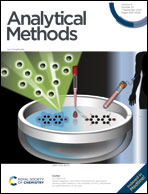A modified electrode based on a 3D reduced graphene oxide and MoS2 composite for simultaneous detection of sunset yellow and tartrazine†
Abstract
A 3D reduced graphene oxide (3DrGO) composite loaded with cauliflower-like MoS2 was prepared. Benefiting from the synergistic effects of 3DrGO and cauliflower-like MoS2, a glassy carbon electrode (GCE) modified with the 3DrGO–MoS2 composite (3DrGO–MoS2/GCE) displays high sensing performance for sunset yellow (SY) and tartrazine (TZ) at working potentials of 0.795 and 1.034 V. Furthermore, a well separated oxidation peak potential can achieve simultaneous detection of the two analytes. Under selected conditions, the peak current exhibits a piecewise linear relationship with the SY concentration in the range of 0.05–10 μmol L−1 and 10–60 μmol L−1, and the plot of peak current versus the TZ concentration also exhibits two linear segments in the range of 0.1–6.0 μmol L−1 and 6.0–60 μmol L−1. The detection limits of SY and TZ are as low as 17.6 and 37.4 nmol L−1, respectively. The prepared 3DrGO–MoS2/GCE was applied for the determination of SY and TZ in food samples with excellent recoveries of 95.1–105.4%.



 Please wait while we load your content...
Please wait while we load your content...